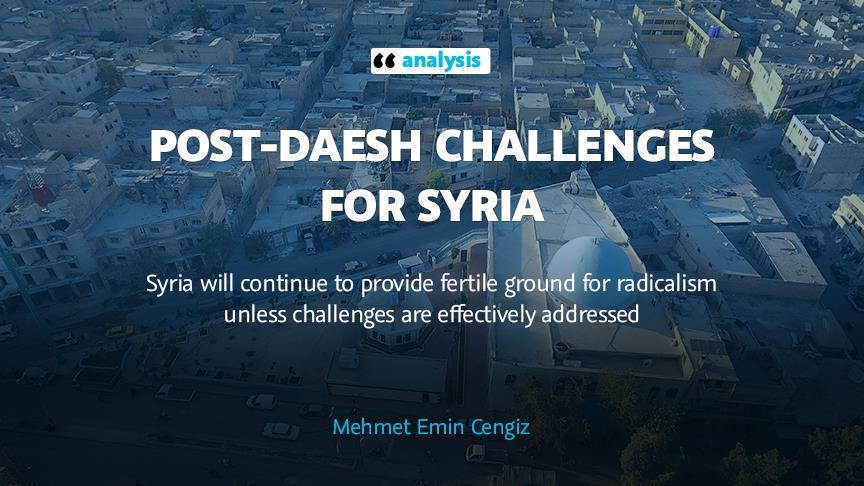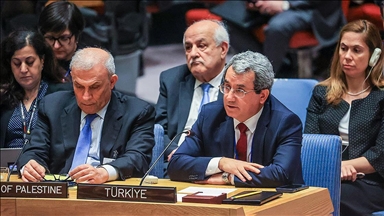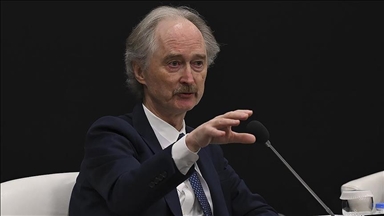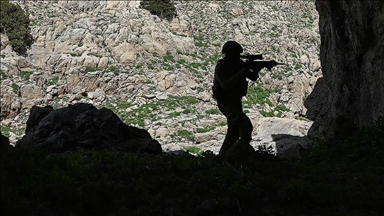ANALYSIS - Post-Daesh challenges for Syria
Syria will continue to provide fertile ground for radicalism unless challenges are effectively addressed

By Mehmet Emin Cengiz
ISTANBUL
With the immensely destructive impact of war in Syria wearing off, the Syrian regime has gained the upper hand in the country. The Syrian crisis, which started out as a national conflict, swiftly took on a regional and international character with the participation of regional and global powers in the war. Interferences by foreign powers deepened the crisis across the country. As a consequence, the roles of the Syrian actors gradually diminished while foreign powers began to play increasingly bigger roles.
In the beginning of the war, the opposition forces had captured most of the country. However, through the interventions of the allies of the regime, the situation changed dramatically. After Iranian-backed ground forces, supported by the Russian air force, came into play, the opposition forces lost most of the territory they had previously captured. Beside these, infighting [1] between opposition forces was another reason behind losing territory to the Syrian regime.
During the war, the allies of the Syrian regime supported its leader Bashar al-Assad consistently. For example, Iran has lost hundreds of its soldiers, among them a number of high-ranking military officers in addition to the economic losses well amounting to billions of dollars. Russia has also lost soldiers during the clashes, albeit much smaller in number.
We should remember that the foreign powers became embroiled in the conflict mostly through their proxies. Iran is the leading country in this regard. Moreover, the U.S. tried to expand and deepen its influence via the Syrian Democratic Forces (SDF), which is an umbrella entity, consisting mainly of the terrorist PKK’s Syrian offshoot YPG. [2]
The help the ally countries gave to the opposition did not persist as they were forced to reconsider and change their policies in Syria under changing circumstances.
Despite all these interventions and recent developments, it is highly unlikely that the conflict will end any time soon. It is difficult to end the war in Syria as it entails building security and stability across the country, which remains a gigantic task.
In view of the massive destruction in Syria, one can safely estimate that it will take the country decades to achieve stability. It will also be really difficult to reconstruct the country and put life back on normal track.
Post-Daesh Syria
In addition to these challenges, the war against Daesh in Syria is reaching an end, at least in territorial form. Even though this does not herald a smooth passage to a post-crisis era for Syria, Syrian actors must ask themselves a number of questions to be able to embark on a transition period from a post-Daesh era to a post-crisis one, however distant it may seem presently.
Who will be the main actors in Syria after the crisis? Is it possible to create a unitary state and a centralized government in Syria? Can we integrate the non-state armed actors into the political system? If so, how can we achieve that? To what extent will the non-state armed actors be represented in the government? How will Syria solve the problem of foreign fighters? Will the Syrian public, severely traumatized by the war, be able to reach a consensus and create a national identity? These are some of the compelling questions that spring to mind.
Is it possible to create unitary state and centralized government in Syria?
To say that the Syrian war is complicated would be an understatement. It is also extremely multidimensional. The actors involved in the war have different ideologies, zones of influence, and political aims. This has resulted in the country’s being divided into four parts thus far. The catastrophic disintegration of the country is all too obvious. There are cities totally disconnected from other cities. In addition, the regime is not economically strong enough to provide basic services to the public. An already weak system became severely debilitated during the war. On the other hand, the situation in the PYD-held areas, as well as those under opposition control, are not ideal either. Hence it seems that it is really difficult to create a unitary state and a highly centralized government in Syria.
A centralized government in Syria was one of the topics of discussion at Astana talks. However, this does not seem possible due to several reasons. First, the regime has no capacity to control the whole country in the post-Daesh era since it lacks the necessary manpower and financial support. Additionally, the regime faces difficulties when it comes to wielding total control over its military forces. The National Defense Forces (NDF), for example, a militia army formed to support the Syrian Army, had clashes with the Syrian Arab Army. The NDF is linked to Iran. Moreover, NDF officials enjoy a certain degree of autonomy and can make their own decisions in their zone of influence. Due to these reasons, creating decentralized administrations based on power-sharing among different actors seems more reasonable than trying to create a centralized government. [3]
This is not true only of Syria. Establishing decentralized administrations based on power-sharing among different actors has been becoming a strong trend in the post-Arab spring era. [4] The pursuit of a new regional order calls for this. The regime is also aware of the situation. Not long ago, Walid Muallem, the regime’s foreign minister, stated that autonomy [5] for Kurds was negotiable and it could be a topic of discussion within the context of the Kurdish population.
And new questions emerge at this point. How can such decentralized administrations be formed in Syria? Which actors would be involved in this process? Which actors would govern which areas? Which criteria would be considered in creating these administrations? Will the warring actors respect the demographic structure? Will we see administrations based on ethnicities and sects or not? The anwers to these questions are not clear yet.
Future of non-state armed actors in the country
Likewise, one of the biggest challenges Syrian actors will face in the post-Daesh era is the future of the non-state armed actors in the country. As a matter of fact, no one knows their exact number. [6] The problem of integrating these actors into the political system does not promise an easy process.
Which non-state armed actors will play a role in the future of the country? Which actors can be taken under control, which cannot? Will Syrian actors compromise on some of the armed groups? Which armed actors will be eliminated? These questions are hard to answer as well. We may say, for instance, that some factions within the Free Syrian Army (FSA) are easy to negotiate/compromise with. This is, however, not the case with the non-state armed actors that have a transnational Jihadi ideology. This challenge will remain a matter of debate in the post-Daesh era. In this era, the willingness of the non-state armed actors to accept political processes will be the main criterion in the integration process.
In addition to these, some of the non-state actors, such as Iranian-backed Shiite militias as well as the SDF, will be a big challenge for Syria in the upcoming period. At this stage, non-state armed actors have become very important in the pursuit of a new regional order. Non-state armed actors, which owe their existence and powers to Iran or the USA, will act in line with the interests of their supporters in the post-Daesh era in Syria.
Future of foreign fighters
Another important problem in Syria is the foreign fighters. Their numbers are expressed in thousands. It is difficult to put an exact figure on those who joined the war from abroad. However, the U.S. State Department estimated that the number exceeded 40,000 [7] as of mid-2016. These fighters can be categorized into three main groups: Sunni fighters, Shia fighters, and westerner, secular, and mostly leftist fighters.
Most of the Sunni fighters are fighting in radical Jihadi groups, such as Daesh or Hay’et Tahrir al-Sham (HTS). Iran, on the other hand, has been recruiting tens of thousands of mostly sectarian foreign fighters from different countries, including Afghanistan [8] and Pakistan. Iran is doing this under the guise of ‘Protecting Shia shrines in Syria’. It has also put these fighters on payroll and sends them to war zones. These fighters are fighting alongside the regime.
The international media generally focuses on voluntary foreign fighters within the opposition factions, but the presence of the Shia Jihadi fighters should not be ignored. Likewise, there are hundreds of westerner, secular and mostly leftist foreign fighters that have participated in this war. [9] Most of them are fighting in the ranks of the SDF.
Another important point that should be emphasized regarding the international community’s stance towards Shia fighters is, it does not consider them as a threat since it is thought that Iran has the power to send these fighters back to their own countries. However, it should not be forgotten that these well-equipped and well-trained fighters pose a major threat to the rest of the world as well. Moreover, they have a feeling of accomplishment due to the situation they helped to shape in Syria. Iran might well try to use these fighters to shape politics and boost its influence in Syria in the future.
Besides, most of these fighters do not take the local dynamics into consideration, which creates anger and hatred among the public towards them. Most of these people will not be able to return to their home countries. If they do return, they will face prison terms and other forms of punishment, such as social ostracism. However, it will not be possible for them to stay in Syria as well. Therefore, for most of these people, fighting seems like the only option. This problem has happened before in different conflict zones, such as Bosnia-Herzegovina, Chechnya, and Afghanistan, to name a few. Most of the fighters that fought in these countries were forced to leave the conflict zones in the wake of the crises. For example, in the case of Afghanistan, those fighters who could not return to their countries, sought refuge in the mountains of the country. In the case of Syria, however, the situation is more complicated. The opposition is in a very unfavourable situation in terms of protecting itself in the first place, let alone the foreign fighters in their midst. Worse, some of these fighters have families in Syria and this makes the situation more fragile and complicated.
The foreign fighters problem is not particular to Syria. It is international. What makes the Syrian case different these days is, it is dealing with its consequences. Therefore, the international community must think about this problem too. The evolution of this process will be a very big problem for the Syrian actors that want to have a share in the post-Daesh era.
Difficulty of creating national identity among different segments of public
Given the level of destruction in Syria, we can say that it is difficult for Syrian actors to reach a consensus and unify under a single national identity; namely, being ‘Syrian’ as an overarching identity. There were regional identities before the war, formed around belonging to major urban centers, such as Aleppo or Damascus.
But now more and more regional, ethnic, and sectarian identities will likely emerge in the post-Daesh era. Firstly, the borders will be controlled by the actors that actually fought on the battlefield. Secondly, the war has been permanently etched in the social memory of the Syrian people. Besides this, the destruction of the country in this brutal fashion has fuelled hostilities and ratcheted up tensions among different segments of the public. Although people will not easily recover from the wounds of the war, the Syrian actors must definitely consider creating a rehabilitation program to heal these profound wounds. The question begs itself here: what kinds of rehabilitation programs could they possibly provide? This question is waiting for a response as well.
Reconstruction challenges
Syria’s reconstruction will be yet another problem issue in the post-Daesh era. The reconstruction [10] cost of Syria is estimated at $300 billion. It is not clear who can fund such a colossal sum. Many doubt the Syrian actors will ever be able to secure such huge funding. Even if they find the funds, other questions will arise. Which conditions will be taken into consideration in transferring the funds to the country? By which channels will the funds be transferred to the country? Will the Syrian regime receive the funds directly? Will these funds not strengthen the regime?
At this point, preventing the regime from being the only actor that will reconstruct Syria is crucial. Sinan Hatahet, a senior associate fellow at Al Sharq Forum, says that the local councils [11] in Syria should be supported. A certain economic autonomy should be given to the local councils in order to prevent the regime from creating a monopoly on the funds. In this way, the funds can be transferred to the councils directly without sending them through Damascus. As for transparency, a mechanism should be created for monitoring the actors that will receive these funds.
All in all, the aforementioned points and questions are essential debates that Syrian, as well as regional and international actors, must think hard about in regard to the post-Daesh era. It should not be forgotten that Syria will be a very fragile place in the post-Daesh era. The state structure is rickety, and the population does not get enough support. Under the given circumstances, it seems very difficult for the people to ever get a chance to create their own civil society. Therefore, Syria will continue to provide a fertile ground for radical movements unless the challenges are effectively addressed.
[ Mehmet Emin Cengiz is a research assistant at Al Sharq Forum ]
* Opinions expressed in this article are the author’s own and do not necessarily reflect the editorial policy of Anadolu Agency.
Anadolu Agency website contains only a portion of the news stories offered to subscribers in the AA News Broadcasting System (HAS), and in summarized form. Please contact us for subscription options.







